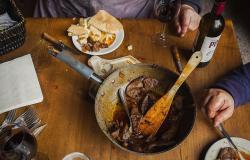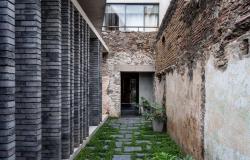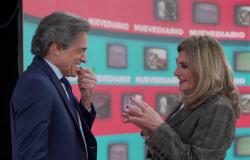“Your house is my house,” Mexicans say. The Soviet before and after after the death of Stalin and those residential pigeon houses known as the “Khrushchevkas”. The same goes for Le Corbusier’s “living machines” in the French capital. Or the American dream expressed through the suburban conglomeration of it. If the national identity is expressed through its homes, LXS Fernández’s house (premieres this Saturday at 7 p.m. on IP) takes the task of analyzing two centuries of Argentina with its particular docufiction project. “Or how housing typology reflects a certain era,” says its ideologue Francisco “Pancho” Yofre . Every Saturday two episodes of the delivery will be broadcast on the pay TV signal winner of the Incaa National Series contest (2019).
Lxs Fernández’s house It offers multiple and spacious environments to be explored. From the fictional framing, along with interviews and archival material, plus the animations of Ayar Blasco (Mercano, the Martian). On the one hand, there is the story of Walter Fernández, an illustrator who is going through a vocational crisis (played by the series’ animator himself) who must take care of his aunt’s health (Sandra Sandrini). He will be assisted in this task by his friend Julieta (Sofia Gala Castiglione), a sort of moral guideline about what happens with that big house that makes a construction company drool. “On a site like this, you know the building, the tower, the amenities we could get,” says a character there.
At the same time, Walter is late with the delivery of the illustrations for a book titled 200 years of Argentine homes. Excuse for the documentary leg to emerge about different square meters, rancherías, or the total absence of housing, plus the opinions of referents and those involved in the matter (Jaime Sorín, Eduardo Blaustein, Pitu Salvatierra, María Pía López). Tell your director Lucía Vasallo (exquisite corpse) that tackling this project also included several sketches before laying the first narrative brick. “Mine was like putting all the pieces together,” says the director. “The idea was to mix fiction, through the adventures of a certain family with its genealogical ancestry and what is happening now with a property that can be made into money. And that serves as an entry for the hardest documentary anchoring,” adds Yofre.
The project began to take shape in Yofre’s mind since the time of the land occupation in the Indo-American Park. He became “hooked on the topic, building bridges” until he mentioned it to a militant documentary reference like David “Coco” Blaustein. The realization of Zafra, significantly, resulted the last job of the maker of Utopia hunters, Spoils of war and Make homeland, among other renowned feature films. “We even made Coco act: when the first chapter starts, he is the one who plays Walter’s father. He was the father of the series, he had to do it. I denied the idea but in the end one day I went home, he waited for me with dough and told me that he had studied the lyrics,” says the director. In addition to the humor and certain traditional notes, the political seal is also present in the series.
Each episode explores the tension between housing models ranging from the real estate development of the ’90s in Puerto Madero and its contrast with the lack of housing for the needy sectors. Or about the building reform in Buenos Aires in the ’60s with the well-known eradication of the villas in the northern part of the city, passing through the Californian houses of the Eva Perón Foundation, the chorizo houses, tenements, palaces of the oligarchy until you reach the house in colonial times. “Every home expresses a moment, directly or indirectly. The Peronist chalecito took the ideas of social advancement, but copied Disney movies. According to what Daniel Santoro tells, when Evita promoted Peronist housing she took into account that people watched Hollywood movies. The house was for mom, dad, children and dog. The horizontal property law, not to mention. Then you have the ’90s with the financing of public space, or how the public becomes private. In one way or another, everyday life is always expressed in these constructions,” says Yofre.
-How difficult was that operation of mixing fiction, animation and documentary?
Lucia Vasallo: -Like all audiovisual processes, it took time. When they called me there was a certain idea and then we took it towards another type of construction due to the resources we had. We didn’t have the time to do anything from the period, but we had to tell two hundred years of history, so the biggest challenge was mixing the eras. Then the animation thing occurred to me and Ayar Blasco always seemed very funny to me, he has a 2D animation style with a very particular imprint. I like Ayar as a cartoonist and actor, I am a friend of Sofia Gala Castiglione, they are friends, I proposed it to the producers. In fact, we were cooking with what we had in the refrigerator. Then we stopped during the pandemic and just started again in 2021.
-The episodes begin with the following quote: “inhabiting is the present of memory.” Why that choice?
LV: -It was a horizontal decision. The whole project was quite horizontal. I think Coco suggested it to me and it was very close to the concept of the series. It fit with what Pancho proposes. It is not an architectural documentary but a sociological and political one.
Francisco Yofre: – We did not want to go astray with the architectural but to escape from the niches of the specialist. Of course it is full of architects, but we wanted to talk about customs. Example: where did the butler stand based on the layout of an aristocratic house? That could sing to you or reveal what social stratum he was from. Not to mention the tenements. This project served for someone, who is involved in politics, to talk about these things. Of socialist houses versus Catholic houses. A century ago the dispute between them was also settled in a type of house. You go to Los Andes Park, the maximum socialist expression, and it has a provision so that naturally those who lived there would have assemblies. The Catholics, with the National Cheap Houses Commission and all their philanthropy, had another idea that they sought to capitalize on or oppose the socialists.
-What surprised you most in your research on ways of living?
LV: -I learned a lot and discovered things that I can now make analogies with. What is happening now is very strong. It reminds me a lot of the tenants’ strike at the beginning of the last century. There are many similarities with the broom strikes. I began to see very similar demands led by women in Facebook groups. It is just like what Pancho investigated. There are many parallels. What is happening with uncontrolled construction in some neighborhoods…
FY: -What raises a question for me is, following this thread of political ideas embodied in homes, what is Milei’s home going to be? Maybe we won’t see it now, maybe it will be years away. Yes, obviously, we can throw the bait with the ’90s and neoliberalism. The architect who sold the Puerto Madero project to Menem appears in the series and is very honest in his description. Milei has something very disruptive, very ultra, very everything. Will there be a type of mileist housing? Maybe it’s a lot.
LV: -What was the first thing Milei did? Release the owner and tenant. We are in a legal moment where we can do anything. In Palermo you see the buildings that already have an Airbnb model. They are not family homes. That’s the model. Make a Puerto Madero of the city, especially the most lucrative neighborhoods.
FY: -Possibly that would have to be chapter seven, dedicated to apartments with Airbnb logic.






